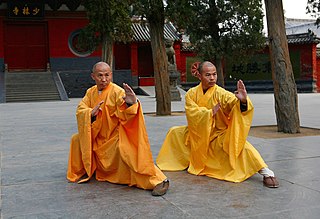
Neijia is the collective name for the internal Chinese martial arts. It relates to those martial arts occupied with spiritual, mental or qi-related aspects, as opposed to an "external" approach focused on physiological aspects. The distinction dates to the 17th century, but its modern application is due to publications by Sun Lutang, dating to the period of 1915 to 1928. Neijing is developed by using neigong or "internal changes", contrasted with waigong or "external exercises".

Chinese martial arts, often called by the umbrella terms kung fu, kuoshu or wushu, are multiple fighting styles that have developed over the centuries in Greater China. These fighting styles are often classified according to common traits, identified as "families" of martial arts. Examples of such traits include Shaolinquan (少林拳) physical exercises involving All Other Animals (五形) mimicry or training methods inspired by Old Chinese philosophies, religions and legends. Styles that focus on qi manipulation are called internal, while others that concentrate on improving muscle and cardiovascular fitness are called external. Geographical associations, as in northern and southern, is another popular classification method.
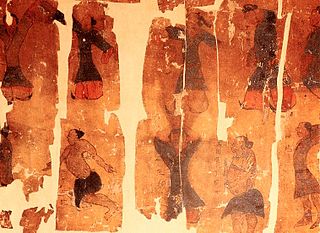
Daoyin is a series of cognitive body and mind unity exercises practiced as a form of Daoist neigong, meditation and mindfulness to cultivate jing (essence) and direct and refine qi, the internal energy of the body according to traditional Chinese medicine. These exercises are often divided into yin positions and yang positions. The practice of daoyin was a precursor of qigong, and was practised in Chinese Taoist monasteries for health and spiritual cultivation. Daoyin is also said to be a primary formative ingredient in the well-known "soft styles" of the Chinese martial arts, of tai chi, and middle road styles like Wuxingheqidao.

Dantian is a concept in traditional Chinese medicine loosely translated as "elixir field", "sea of qi", or simply "energy center". Dantian are the "qi focus flow centers", important focal points for meditative and exercise techniques such as qigong, martial arts such as tai chi, and in traditional Chinese medicine.
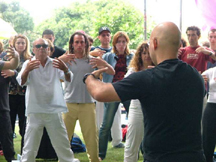
Zhan zhuang is a training method often practiced by students of neijia, such as yiquan, xingyiquan, baguazhang and tai chi. Zhan zhuang is sometimes translated Standing-on-stake, Standing Qigong, Standing Like a Tree, Post-standing, Pile-standing, or Pylon Standing.
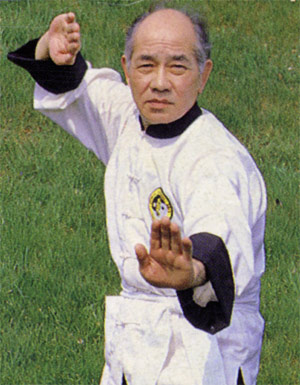
The Lee style of tai chi (李氏太極拳) is closely related to a range of disciplines of Taoist Arts taught within the Lee style including Qigong, Daoyin, Ch'ang Ming, Traditional Chinese Medicine, Taoist alchemy, Feng Shou kung fu, and weapons practice. According to practitioners, it was first brought to the West in the 1930s by Chan Kam Lee and was subsequently popularized by Chee Soo who was the President of the International Taoist Society from 1958 until his death in 1994. The Lee style of tai chi comprises two forms known as 'the dance' and 'the form'. Other exercises include Yifu Shou or 'sticky hands', Whirling Hands, Whirling Arms, and various qi and Li development exercises. Lee style t'ai chi is related to Martial Arts training, and there are five distinct areas of development that comprise the whole Art:
- Physical
- Mental
- Breathing
- Sheng Qi
- Ching Sheng Li.
Neigong, also spelled nei kung, neigung, or nae gong, refers to a series of internal changes that a practitioner goes through when following the path to Dao, and these changes may be achieved through practices including qigong or tai chi. Neigong is also associated with xingyi quan.

In Chinese martial arts, there are fighting styles that are modeled after animals.
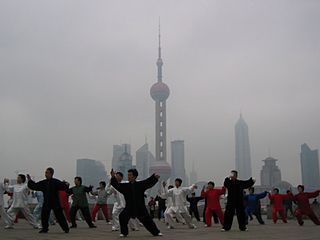
There are hundreds of different styles of Chinese martial arts, each with their own sets of techniques and ideas. The various movements in kung fu, most of which are imitations of the fighting styles of animals, are initiated from one to five basic foot positions: normal upright posture and the four stances called dragon, frog, horse riding, and snake.
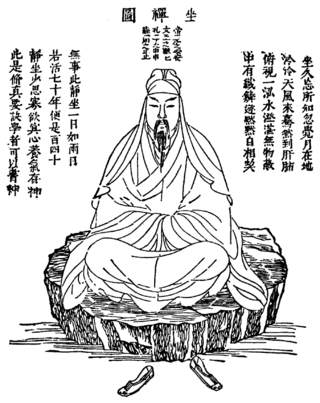
The microcosmic orbit (小周天), also known as the Self Winding Wheel of the Law, is a Taoist qigong energy cultivation technique. It involves deep breathing exercises in conjunction with meditation and concentration techniques which aim to develop the flow of qi along certain pathways of energy in the human body which may be familiar to those who are studying traditional Chinese medicine, qigong, tai chi, Neidan and Chinese alchemy. The exercise can be performed usually at first in a sitting position, but it can also be practiced standing as in Zhan zhuang or with movements included as with tai chi.
Conscious breathing encompasses techniques directing awareness toward the breathing process, serving purposes from improving respiration to building mindfulness. In martial arts like tai chi and qigong, breathing exercises are said to strengthen diaphragm muscles and protect organs, with reverse breathing being a common method. Meditation traditions, including yoga and Buddhist meditation, emphasize breath control. Yoga's pranayama is believed by practitioners to elevate life energies, while Buddhist vipassanā uses anapanasati for mindfulness of breathing.
Stephan Berwick is an American author, martial artist, and actor known for his scholarly research on traditional Chinese martial arts – particularly Chen-style taijiquan, and roles in early Yuen Wo-ping Hong Kong Action films.

Bruce Kumar Frantzis is a Taoist educator who studied Taoism in China.
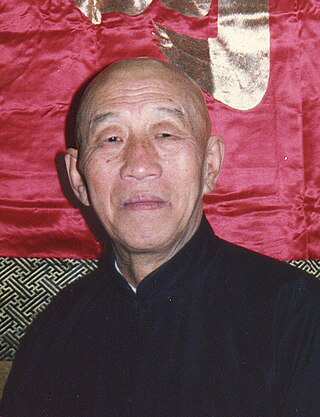
Kuo Lien-ying, was one of the most distinguished and revered martial artists of the twentieth century. He brought the Guang Ping Yang tai chi to the United States.
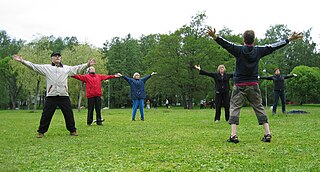
Asahi is a Finnish health exercise based on the eastern traditions of tai chi, qigong, yiquan and yoga, with a western scientific viewpoint.
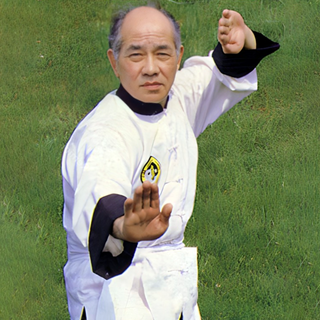
Chee Soo was an author of books about the philosophy of Taoism and in particular Lee-style tai chi, qigong, Ch'ang Ming, Traditional Chinese Medicine and Feng Shou 'Hand of the Wind' kung fu.
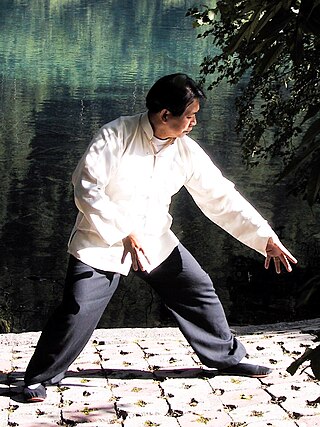
Qigong, is a system of coordinated body-posture and movement, breathing, and meditation said to be useful for the purposes of health, spirituality, and martial arts training. With roots in Chinese medicine, philosophy, and martial arts, qigong is traditionally viewed by the Chinese and throughout Asia as a practice to cultivate and balance the mythical life-force qi.

Doc-Fai Wong is a master of tai chi and the Hung Sing branch of Choy Li Fut kung fu. He was born in 1948 in the Guangdong province of China, specifically, the Wangshan village in the Doumen District of Zhuhai. In April 1960, he and his mother immigrated to San Francisco, California to be reunited with his father. He arrived as a third-generation citizen of the United States of America since both his grandfather and father were already citizens. He sought out his first kung fu teacher - Lau Bun (劉彬), the founder of the first Hung Sing Kwoon of Choy Li Fut in America, after encountering taunting and bullying due to language and ethnic difficulties after his arrival. When Lau Bun died in 1967, he started teaching and opened his first school when he was 19 years old.

Wudangquan is a class of Chinese martial arts. In contemporary China, Chinese martial arts styles are generally classified into two major groups: Wudang (Wutang), named after the Wudang Mountains; and Shaolin, named after the Shaolin Monastery. Whereas Shaolin includes many martial art styles, Wudangquan includes only a few arts that use the focused mind to control the body. This typically encompasses tai chi, xingyiquan and baguazhang, but must also include bajiquan and Wudang Sword. Although the name Wudang simply distinguishes the skills, theories and applications of the internal arts from those of the Shaolin styles, it misleadingly suggests these arts originated at the Wudang Mountains. The name Wudang comes from a popular Chinese legend that incorrectly purports the genesis of tai chi and Wudang Sword by an immortal, Taoist hermit named Zhang Sanfeng who lived in the monasteries of Wudang Mountain. Wudang quan is often used synonymously with Neijia, but Neijia is a broader term that also encompasses Aikido and Qigong, which are not Wudang quan.
Kenko Kempo Karate is a hybrid martial art system aimed at people over 40 years of age. It is a methodology to adapt Eastern martial arts to the needs of persons of advanced age, for both novices as well as experienced practitioners. It aims at health, wellness, and self-defense. The system can be adapted to most martial arts but consistently uses tai chi forms as part of the training programme.












